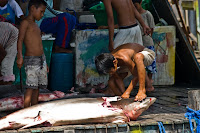On my recent trip to layang-layang we had the pleasure of seeing mantas. Such beautiful and graceful creatures that are truly breathtaking to watch and appreciate. But yes many people take to chasing them or disturbing them on cleaning stations. If they are curious and comfortable they will come towards you... imagine a stranger chasing you down the road trying to take a picture of you or touch you! So being curious I decided to read a little bit more about them and share it with you, if you are interested.

Extracted from Dive-The-World.com
Distinguishing Features
Mantas can grow to 6.7m wide, weigh up to 1,400kg, and are the largest of all rays. The Spanish word for blanket is 'manta' and aptly describes the unique spherical body shape of this animal.
Also known as "devil ray" with graceful pectoral 'wings', manta rays are easily recognised by their paddle-like cephalic lobes projecting forward from the front of the head (actually extensions of the pectoral fins, supported by radial cartilages), and a very broad, rectangular terminal mouth.
Mantas vary in colour from black, grey-blue, to red-brown on the upper surface of their cartilage body, sometimes with white shoulder patches and blotches, and almost pure white on the lower surface of their pectoral fins and body disc. Their body patterns show individual variation and helps identify individuals.
There are also regional differences in manta ray colour patterns. For example, specimens from the eastern Pacific often feature dusky to mostly black undersurfaces, while those from the western Pacific are typically snow white underneath.
Although it's difficult not to recognise an adult manta ray, juveniles are similar to mobula rays (of which there are 9 species) that grow to 3 metres and share paddle-shaped cephalic lobes and gracefully curved pectoral wings. Mantas are now thought to be a single species, and mobulas are most readily distinguished by the position of the mouth - mobulas have sub-terminal mouths (located underneath the head, similar to many sharks), whilst mantas have terminal mouths (located at the front of the head).
Behaviour
A manta ray is capable of rapid speed and juveniles sometimes leap well clear of the water, landing with a loud slap, sometimes performing 2 or 3 of these jumps in succession. The act seems to be playing or social behaviour - the great, crashing splash of their re-entries can often be heard from miles away. Getting rid of parasites may also play a role, much like breeching whales.
Manta rays frequently visit reef-side "cleaning stations" to let cleaner wrasse remove small parasites from skin and gill cavities, sometimes several lining up to wait their turn.
Seemingly inquisitive, manta rays may sometimes approach and even solicit attention from divers, apparently enjoying the tactile stimulation provided by human contact as well as the bubbles from scuba units. In areas frequented by divers, however, they often become very wary and cease to approach.
When approached rapidly or grasped, they roll onto their backs, dive, or swim away rapidly, righting themselves only when some distance away. Entering the water carefully so as to not scare manta rays away will greatly increase the enjoyment of your encounter and protect them from injury. Hovering and staying still will eventually allow the manta ray to approach you. It's best to position yourself a long the bottom or near a cleaning station to observe them close up.
Touching a manta ray, even if they present their bellies for a rub, will remove some of the mucus that protects them against marine infections. Stay within their vision and let them decide if they want to approach you. Although some manta rays seem to enjoy the bubbles from the SCUBA unit on their bellies, avoid exhaling bubbles into their face, as it may scare them off.
Flash photography and video doesn't seem to bother the manta ray, but do not disturb them if they are engage in feeding, cleaning or mating. Direct eye contact is considered a friendly connection, which they also seem to enjoy. Remember to never ride a manta ray, event though it may appear as if they present themselves for a ride.
Reproduction
The manta ray is ovoviviparous with a usual litter size of 2 - each pup wrapped in a thin-shell that hatches inside the mother, later to be born alive. Birth occurs in relatively shallow water, where the young remain for several years before expanding their range further offshore. Like sharks and other rays, mantas are fertilized internally. The fertilized eggs develop inside a mother manta's body for an unknown length of time that may exceed 12 months.

So those that dive please help conserve the beauty for generations to come.
Peace, Love and Respect,
Jenn




